Myth 1: Seals only forage at night.
 Fact: Seals feed both during the day and at night, although this varies depending on age and sex class.
Fact: Seals feed both during the day and at night, although this varies depending on age and sex class.
Monk seals as a whole do not appear to prefer feeding at specific times of the day. This misperception is derived from dietary and behavioral observations. Monk seal diet studies found that seals eat a mixture of diurnal and nocturnal species. Though seals are consuming nocturnal species, they are not necessarily consuming them only at night. Nocturnal prey, such as eels and cephalopods, like to hide in crevices and rocks during the day, and footage from seal-born video cameras (crittercams) show seals probing and overturning rocks to flush and capture prey. Observations of seals on the beaches showed that the highest number ashore were mid-day with fewer animals in the morning and early evening, leading to the assumption that seals were primarily nocturnal foragers. However, new technology such as dive recorders and satellite tags are showing no significant difference between day and night feedings.
Myth 2: Seals eat too much of the fish targeted by fishermen. This poses a problem if the main Hawaiian Islands (MHI) seal population grows.
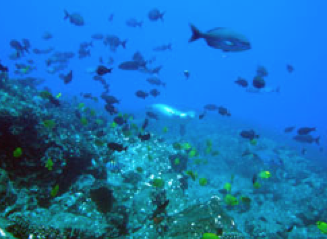 Fact: Considering what science tells us about monk seal foraging, the overall impact of seals on fishing in Hawaii (recreational, subsistence, and commercial) is small.
Fact: Considering what science tells us about monk seal foraging, the overall impact of seals on fishing in Hawaii (recreational, subsistence, and commercial) is small.
The potential impact of seals on fishing in Hawaii is influenced by several factors:
There are a small number of seals in the MHI (~300 seals) – Seals consume a wide variety of marine organisms (not just fish), and many are species not targeted by fishers
Seals forage over wide areas, including habitats and depths not targeted by fishers – Even as the MHI seal population may grow naturally, their impacts on fisheries are expected to be very small as the overall MHI population will still be relatively small.
However, there could be impacts to individual fishermen when seals interact with their gear or catch. Guidelines have been developed to minimize these impacts. Review NOAA’s fisheries interactions guidelines for more information on how to avoid seal interactions.
Myth 3: Monk seals eat 400 pounds of fish per seal per day. Or, monk seals eat their weight in fish every day.
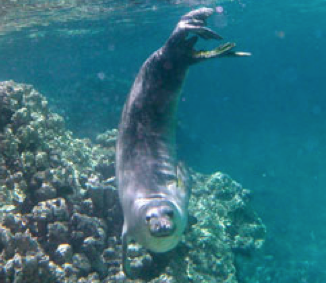 Fact: This is impossible. No large carnivore (meat eating animal) consumes the equivalent of its body weight in a day.
Fact: This is impossible. No large carnivore (meat eating animal) consumes the equivalent of its body weight in a day.
Very small animals, like shrews, hummingbirds, and some insects, etc., must consume large amounts of food relative to their size, but not marine mammals, including monk seals. Given the size of the monk seals stomach (only slightly larger than our own) it is actually impossible for monk seals to consume and digest that quantity of food.
Monk seals eat about 4-8% of their body weight, depending on the age class of the seal. If there is an increasing population of seals in the main Hawaiian Islands (MHI) there is concern that seals may be negatively impacting the local ecosystem. A recent study estimated that a MHI seal consumes about 6.8 kilograms (15 pounds) of fish per day, which is only 0.009% of estimated available prey biomass. With 7,622 square kilometers (2,943 square miles) of foraging habitat in the MHI and an estimated monk seal population size of 300, this translates to a total consumption rate of about 0.45 kilograms (1 pound) of fish per square mile per day per seal.
Myth 4: Seals damage coral reefs as they hunt for food and thus damage fish habitat. This will get worse if the main Hawaiian Islands (MHI) population.
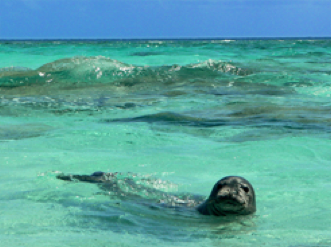 Fact: Seals rarely damage live coral while they forage – they do sometimes lift or turn over rocks and root around in rubble and sand, but this material is not live coral, and this activity does not damage the ecosystem nor reduce the productivity of the fishery.
Fact: Seals rarely damage live coral while they forage – they do sometimes lift or turn over rocks and root around in rubble and sand, but this material is not live coral, and this activity does not damage the ecosystem nor reduce the productivity of the fishery.
There is no evidence, including many of hours of footage from seal-mounted video cameras, indicating that monk seals damage coral reefs.
Myth 5: Seals will attract sharks, which will put people at risk of shark attacks.
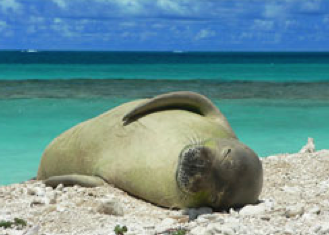 Fact: All information to date indicates that more monk seals in the main Hawaiian Islands (MHI) has not, and will not, lead to more shark attacks on humans.
Fact: All information to date indicates that more monk seals in the main Hawaiian Islands (MHI) has not, and will not, lead to more shark attacks on humans.
While the monk seal population has increased in the MHI over the past 10 years, incidents of shark attacks on people have shown no corresponding increase. According to the International Shark Attack File, there have been a total of only 136 documented shark attacks on people in Hawaii from 1828-2014, and 9 of these were fatal. From 2001-2014, the yearly number of attacks on humans in Hawaii showed no clear upward trend of shark attacks.
Tiger sharks are responsible for most shark attacks on humans in Hawaii, and tiger sharks also attack monk seals. However, only a small fraction of seals in the MHI have scars or new injuries from shark bites. Some studies have documented more white shark attacks on people (especially surfers) near seal colonies (for example, in California and South Africa). These colonies typically involve predictable and seasonal aggregations of tens of thousands of seals, and white sharks focus on these areas when seals are present. In contrast, there are presently around 300 seals in the MHI. These seals are scattered throughout the islands and do not aggregate in dense colonies. These small numbers mean that monk seals cannot be a significant source of food for sharks, because there are not nearly enough seals to sustain the sharks. A similar concern is often heard about the abundance of green turtles and shark attacks in Hawaii. However, despite the fact that green turtle abundance has been growing in Hawaii for decades, there has been no apparent increase in shark attacks on humans during this time.
Myth 6: Seals are a human safety risk because they will attack people.
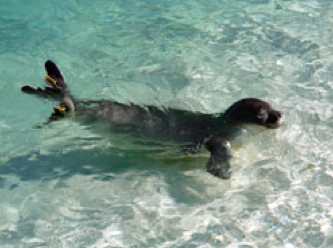 Fact: Most monk seals are not aggressive toward people, unless they feel threatened (such as when a person gets between a mother seal and her pup).
Fact: Most monk seals are not aggressive toward people, unless they feel threatened (such as when a person gets between a mother seal and her pup).
Some seals that have been fed (intentionally or unintentionally) or those that have been interacted with (“played with”) by people may become dangerous when they grow up to be large, mature seals that persistently seek out human interaction.
Normal “wild” monk seals almost never attack or seek interactions with humans. There have been only a few known cases of aggressive interactions between seals and people. These have occurred either when a person has gotten too close to a protective mother’s pup or when a seal has become conditioned to associate humans with food or socialization and later became too “rough” with unsuspecting swimmers or divers.
Myth 7: Monk seals are not from Hawaii and they are being brought in by government agencies.
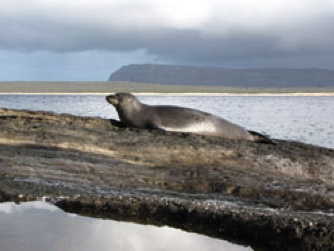 Fact: Monk seals are native to both the Northwestern Hawaiian Islands and the main Hawaiian Islands (MHI).
Fact: Monk seals are native to both the Northwestern Hawaiian Islands and the main Hawaiian Islands (MHI).
All evidence indicates that Hawaiian monk seals are endemic to the Hawaiian Islands, meaning they are only found in Hawaii and nowhere else in the world.
There are documented reports of monk seals sighted in the MHI going back to the 1800s, and archeological remains of monk seals dating to 1400-1700 AD were found on the Island of Hawaii. The Hawaiian monk seal likely reached the Pacific Ocean through the Central American Seaway (now blocked by the Isthmus of Panama) between 3 and 11 million years ago. There is no fossil or reported evidence of Hawaiian monk seals anywhere else in the world, except for in the Hawaiian Archipelago.
Although not as prominent in Native Hawaiian culture as other sea creatures, like sea turtles, recent research reveals that some Hawaiian families have traditional ties to monk seals and there are historical Hawaiian cultural references to monk seals. Many people have not seen or heard much about monk seals in the MHI in the past few generations because they have only recently become more numerous again in the MHI after being hunted to near extension in the 18th and 19th centuries.
The MHI seal population has naturally increased because of better reproductive success of the seals already here, not because seals are moving here from the Northwestern Hawaiian Islands (NWHI).
Myth 8: The seal population in the main Hawaiian Islands (MHI) will explode like other invasive species (e.g., taʻape).
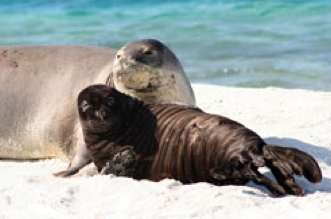 Fact: Many introduced species have indeed become problematic invasive species in Hawaii. However, monk seals are not an alien species and the biology of slow growing native monk seals (a marine mammal) is very different than the biology of Hawaii’s alien species (fish, plants, and land mammals).
Fact: Many introduced species have indeed become problematic invasive species in Hawaii. However, monk seals are not an alien species and the biology of slow growing native monk seals (a marine mammal) is very different than the biology of Hawaii’s alien species (fish, plants, and land mammals).
Monk seals are not an alien species in Hawaii (see Myth 8 above), so they do not have the ecological advantage that some alien species, such as taʻape or mongoose, have when they are introduced into new ecosystems. Female seals, on average, have less than one pup per year, compared to the thousands of offspring produced by alien fish species like taʻape, and the 6 or more offspring per year produced by a small land mammal, like a mongoose. Even among all types of pinnipeds (seals and sea lions), all of which are relatively slow reproducing species, the monk seal population appears to be among the slowest growing, even when conditions are favorable for population growth. This may be partly because Hawaii’s subtropical marine ecosystem is much less productive than the temperate and arctic ecosystems where the other pinnipeds live. Contrary to what it may seem, coral reef ecosystems have very low levels of nutrients in the water – that’s why the water is so clear. Temperate and arctic ecosystems, on the other hand, have relatively high nutrient levels and thus can support higher biological production and higher populations of pinnipeds.
Based on the best information available, it is believed that the monk seal population in the MHI is currently neither growing or falling. Based on sophisticated computer-based modeling to estimate future populations, it is thought that due to natural “saturation rates” and the current population size, it is predicted that the number of Hawaiian monk seals in the MHI could reach approximately 500 to 600 animals by the year 2030 – still a very low number considering the size, extent and complexity of the shoreline ecosystem.
“One way to open your eyes is to ask yourself, “What if I had never seen this before? What if I knew I would never see it again?” – Rachel Carson (Biologist, writer, ecologist, 1907-1964)
